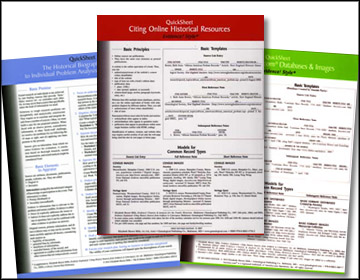 Elizabeth Shown Mills is considered one of the most knowledgeable, if not the top expert, on research citation and verification. Her books, Evidence!: Citation & Analysis for the Family Historian and Evidence Explained and Evidence Explained: Citing History Sources from Artifacts to Cyberspace, provide a detailed exploration into proper research techniques, with a focus on the management of sources through quality analysis and citation.
Elizabeth Shown Mills is considered one of the most knowledgeable, if not the top expert, on research citation and verification. Her books, Evidence!: Citation & Analysis for the Family Historian and Evidence Explained and Evidence Explained: Citing History Sources from Artifacts to Cyberspace, provide a detailed exploration into proper research techniques, with a focus on the management of sources through quality analysis and citation.
Mills has also provided genealogists with the ability to quickly reference key elements of citation and analysis through a series of Quicksheets. These four page, laminated, quick-reference guides are small enough to easily carry on trips to the library and other research destinations. Each provides a review of key skills taught in her books (though reading the books are not necessary to make use of these guides), and easy reference to citing all types of sources. Following is a list of guide previously reviewed on this site:
- QuickSheet: Citing Ancestry.com Databases & Images
- The Historical Biographer’s Guide to Finding People in Databases & Indexes
- The Historical Biographer’s Guide to Cluster Research (the FAN Principle)
- QuickSheet: Citing Online Historical Resources
- Quicksheet: Citing Online African-American Historical Resources
- QuickSheet: Genealogical Problem Analysis – A Strategic Plan
- QuickSheet to Evidence Appraisal
Overview of just a few of these quick guides:
In her books Elizabeth Shown Mills discusses successful research through a series of models. These models are outlined in Quicksheet: The Historical Biographer’s Guide to the Research Process. According to Mills, “reliable research is not achieved by trolling the Internet for a name; using indexes and databases as though they were actual records; or accepting uncritically whatever conclusions others tout.” However, Mills believes success can be achieved through following a set patterns described in her book and outlined in this chart in the following four models:
- The Research Process Model
- The Research Analysis Model
- The Identity Triangulation Model
- The Reliability Model
In The Historical Biographer’s Guide to Finding People in Databases and Indexes Mills provides a basic premise for this guide: “Databases and indexes are valuable tools for research. As finding aids, they can shortcut the process of discovery…Historical records, however, involve vagaries that defy technical formulas.” She suggests that databases and indexes can limit, or even prohibit, discoveries if the researcher does not apply an analytical strategy. Genealogical research requires understanding the nature of those people being studied. Computers cannot understand people and their unique needs. However, one can understand the nature of both one’s ancestors and the systems or tools one uses. Finding solutions begins with understanding problems. The guide suggests strategies to help overcome database and index related issues in finding people. Some strategies provide a pro-active approach.
Quicksheet: Citing Online African-American Historical Resources starts with a review of a few basic principles of citation. The remainder of the guide provides citation “Models for Common Resources.” For each entry type there are three models: a source lists entry, a full reference note, and a short reference note. Each category has at least one entry type, but some have two or three variations. For example, the Blog category supports three types: blog entry (basic format), blog entry (by Guest Writer), and blog entry (by Anonymous Writer). 12 categories are covered in this guide.
All of Elizabeth Shown Mills’ Quicksheets, and her books, are available at Family Roots Publishing:
- QuickSheet: Citing Ancestry.com Databases & Images
- Quicksheet: The Historical Biographer’s Gide to Cluster Research (the FAN Principle)
- QuickSheet: The Historical Biographer’s Guide to the Research Process
- QuickSheet: Citing Online Historical Resource
- Quicksheet: Citing Online African-American Historical Resources
- QuickSheet: Genealogical Problem Analysis, A Strategic Plan
- QuickSheet to Evidence Appraisal